Share The Data: David Haussler Envisions A New Future For Pediatric Cancer
By Leah Rosenbaum
February 22, 2018 | David Haussler wore his trademark Hawaiian shirt underneath a blazer last week in San Francisco. Haussler, who played a seminal role in the Human Genome Project, has been a regular at the Molecular Medicine Tri-Conference*. This year, Haussler came back to the stage to discuss using the power of big data to help pediatric cancer patients.
Haussler, Professor and Scientific Director of the UC Santa Cruz Genomics Institute, first gave the audience some facts about pediatric cancer. In the US, Haussler said, an average of 43 children are diagnosed with cancer every day. Some pediatric cancers are treatable, but many are not. Some, like Diffuse Intrinsic Pontine Glioma (DIPG), are incurable from the moment of diagnosis. It’s also important to understand, he said, that pediatric and adult cancers are very different. Adult tumors usually have hundreds more mutations than children’s tumors, meaning that pediatric tumors have fewer targets for drugs. In addition, most approved drug therapies are targeted towards adult cancers. And finally, pediatric cancers usually progress more rapidly and more aggressively than their adult counterparts.
At UC Santa Cruz, Haussler is the co-founder of the Treehouse Childhood Cancer Initiative, a program that enables the sharing of genomic pediatric cancer data between institutions. He is also a principal investigator of the California Kids Cancer Comparison, which collaborates with other researchers and physicians across the US (many in the UC system), and uses the power of large-scale bioinformatics to analyze patients’ tumors.
At these organizations, Haussler and his team “map” tumors by looking at their RNA. Analyzing RNA allows researchers to look at the expression of individual genes. “Gene expressions,” Haussler explained, “are the consequence of the mutations that are actually driving the tumor.”
Once a tumor is mapped, its genetic expression can be compared to thousands of other tumors from children and adults, and possible targets for drug therapy can be identified. For example, Haussler and his team may find genomic similarities between a current patient’s tumor and the tumor of a patient from the past. By looking at what drug therapies worked and did not work on a similar tumor, they can be more precise when treating the new patient.
Their goal, Haussler said, is to “do the most complete analysis” of each child’s tumor genome, and “leave no stone unturned” when it comes to looking for possible drug targets.

Haussler gave the touching example of a young boy named Kelvin who came into their clinic for treatment. He had central nervous system sarcoma, which had been treated very aggressively with chemotherapy, a stem cell transplant, and radiation. However, two years later the cancer returned and had metastasized to the boy’s lungs. The team was out of conventional treatment options.
Haussler and his co-workers mapped the boy’s tumor, and found something surprising: though it was a cancer of the central nervous system, its genomic expression was closely related to a type of lung cancer. By using this information and analyzing the tumor’s genetic pathway, Haussler and his team were able to find a druggable target for therapy. The boy lived with a high quality of life for two more years before passing away. And while two years may not seem very significant, Haussler said, “that’s important for an eight-year-old.”
Right now, their team’s biggest challenge is getting access to large amounts of genomic data that they can use to map tumors. This is why four years ago Haussler co-founded the Global Alliance for Genomics and Health (GA4GH). Up until this point most genomic data has been siloed within individual research institutions, unshared and unstandardized. The goal of GA4GH is to create a framework and set of standards for sharing genomic data around the world. So far, there are over 500 institutions that participate from 71 countries.
Despite the challenges facing pediatric cancer researchers, Haussler ended the keynote address on an optimistic note. “We have so much new technology,” Haussler said, “that we can go beyond standard care in these cases where there really is no other standard option.”
Every kid with untreatable cancer should get a second chance, Haussler said. And the first step to making that a reality? Share the data.
* The Molecular Medicine Tri-Conference; February 11-16, 2018; San Francisco. The Tri-Conference is produced by Cambridge Healthtech Institute, the parent company of Bio-IT World.


